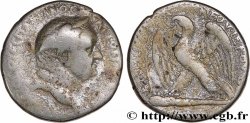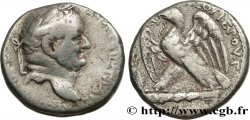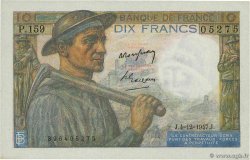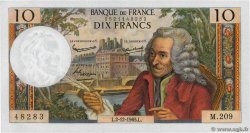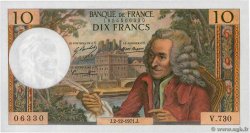bpv_304488 - VESPASIANUS Tétradrachme syro-phénicien
Nicht verfügbar.
Artikel auf unserem Online-Shop verkauft (2014)
Preis : 380.00 €
Artikel auf unserem Online-Shop verkauft (2014)
Preis : 380.00 €
Type : Tétradrachme syro-phénicien
Datum: an 2
Name der Münzstätte / Stadt : Antioche, Syrie, Séleucie et Piérie
Metall : Silber
Durchmesser : 26 mm
Stempelstellung : 11 h.
Gewicht : 14,86 g.
Seltenheitsgrad : R2
N° im Nachschlagewerk :
Pedigree :
Cet exemplaire, qui provient de la Collection McAlee, illustre le type dans le livre Coins of Roman Antioch, c’est l’exemplaire 0103_007 de la base TSP
Vorderseite
Beschreibung Vorderseite Tête laurée de Vespasien à droite, aegis ancienne autour du cou (O*4).
Legende des Averses AUTOKRAT KAISA OUESPASIANOU
Übersetzung der Vorderseite (L'empereur césar Vespasien).
Rückseite
Beschreibung Rückseite Aigle, ailes écartées, à droite sur un foudre, palme verticale dans le champ droit.
Legende des Reverses : ETOUS NEOU IEROU A
Übersetzung der Rückseite (Nouvelle année sainte An 1).
Kommentare
Curieusement, ce qui se rapproche le plus de ces émissions du premier groupe de Vespasien, fort rare, caractérisé par un aigle sur foudre à droite, ce sont aussi bien les émissions du milieu du règne de Néron (Prieur 84 à 89), de dix ans antérieures, que les premières émissions du règne de Domitien. (Prieur 143). Faut-il en déduire qu’il était politique à Antioche, pour un nouvel empereur du premier siècle, de rappeler le souvenir de ces frappes de Néron ? L’aegis si particulière qui les caractérise (dite ancienne et se composant apparemment d’une peau de chèvre et d’un serpent, sans rapport direct avec l’aegis normale, ornement de poitrine rappelant la Méduse) avait-elle une signification particulière pour les Antiochéens ? Si tel est le cas, son identification, si elle peut être confirmée, renvoie au culte de Zeus, comme l’aigle et le foudre. Pourtant, le principal culte d’Antioche semble avoir été dédié à Apollon...
Ce premier groupe, placé là d’une manière arbitraire (il comporte les années A et B, mais comme les groupes 5, 6 et 9), n’a aucun rapport avec les émissions de Galba et d’Othon : faut-il en déduire qu’il n’a pas été frappé à Antioche ou que les frappes de ceux-ci émanent d’une autre ville ? La question reste encore posée. On remarque par ailleurs que les aigles de ce groupe ne portent pas la couronne dans le bec, probablement une distinction accordée à la ville émettrice.
Le premier groupe se termine en l’an 2, numériquement, c’est l’un des plus réduits de l’ample production liée à la guerre Juive.
Les sigma sont traités en C.
Dans la base TSP maintenue par Michel Prieur, treize exemplaires seulement sont maintenant répertoriés.
Curiously, what comes closest to these issues of the first group of Vespasian, very rare, characterized by an eagle on a thunderbolt on the right, are both the issues from the middle of the reign of Nero (Prior 84 to 89), from ten years earlier, and the first issues of the reign of Domitian.. (Prior 143). Should we deduce from this that it was political in Antioch, for a new emperor of the first century, to recall the memory of these strikes of Nero? Did the very particular aegis which characterizes them (said to be ancient and apparently consisting of a goatskin and a snake, without direct relation to the normal aegis, a chest ornament reminiscent of Medusa) have a particular significance for the Antiochians? If this is the case, its identification, if it can be confirmed, refers to the cult of Zeus, like the eagle and the thunderbolt. Yet the main cult of Antioch seems to have been dedicated to Apollo. . .
This first group, placed there arbitrarily (it includes years A and B, but like groups 5, 6 and 9), has no connection with the issues of Galba and Otho: should we deduce from this that it was not struck in Antioch or that the strikes of these came from another city? The question still remains.. It is also noted that the eagles in this group do not wear the crown in their beaks, probably a distinction granted to the issuing city..
The first group ends in the year 2, numerically, it is one of the smallest of the large production linked to the Jewish War.
Sigmas are treated in C.
In the TSP database maintained by Michel Prieur, only thirteen examples are now listed.
Ce premier groupe, placé là d’une manière arbitraire (il comporte les années A et B, mais comme les groupes 5, 6 et 9), n’a aucun rapport avec les émissions de Galba et d’Othon : faut-il en déduire qu’il n’a pas été frappé à Antioche ou que les frappes de ceux-ci émanent d’une autre ville ? La question reste encore posée. On remarque par ailleurs que les aigles de ce groupe ne portent pas la couronne dans le bec, probablement une distinction accordée à la ville émettrice.
Le premier groupe se termine en l’an 2, numériquement, c’est l’un des plus réduits de l’ample production liée à la guerre Juive.
Les sigma sont traités en C.
Dans la base TSP maintenue par Michel Prieur, treize exemplaires seulement sont maintenant répertoriés.
Curiously, what comes closest to these issues of the first group of Vespasian, very rare, characterized by an eagle on a thunderbolt on the right, are both the issues from the middle of the reign of Nero (Prior 84 to 89), from ten years earlier, and the first issues of the reign of Domitian.. (Prior 143). Should we deduce from this that it was political in Antioch, for a new emperor of the first century, to recall the memory of these strikes of Nero? Did the very particular aegis which characterizes them (said to be ancient and apparently consisting of a goatskin and a snake, without direct relation to the normal aegis, a chest ornament reminiscent of Medusa) have a particular significance for the Antiochians? If this is the case, its identification, if it can be confirmed, refers to the cult of Zeus, like the eagle and the thunderbolt. Yet the main cult of Antioch seems to have been dedicated to Apollo. . .
This first group, placed there arbitrarily (it includes years A and B, but like groups 5, 6 and 9), has no connection with the issues of Galba and Otho: should we deduce from this that it was not struck in Antioch or that the strikes of these came from another city? The question still remains.. It is also noted that the eagles in this group do not wear the crown in their beaks, probably a distinction granted to the issuing city..
The first group ends in the year 2, numerically, it is one of the smallest of the large production linked to the Jewish War.
Sigmas are treated in C.
In the TSP database maintained by Michel Prieur, only thirteen examples are now listed.







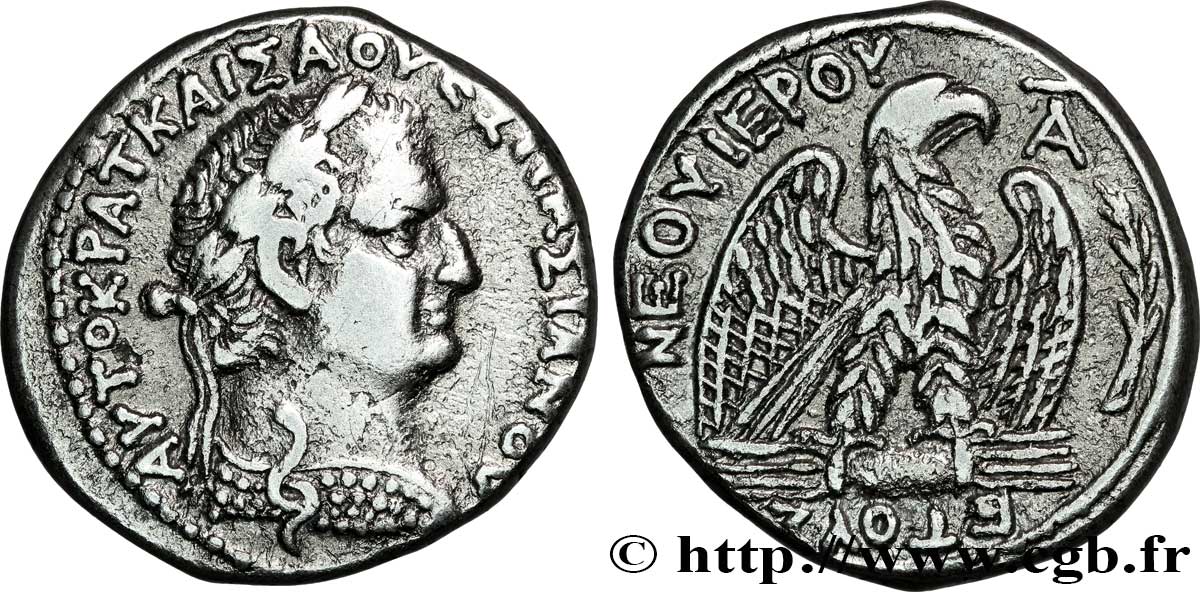
 Berichten über einen Fehler
Berichten über einen Fehler Die Seite drucken
Die Seite drucken Teilen meiner Auswahl
Teilen meiner Auswahl Stellen Sie eine Frage
Stellen Sie eine Frage Einlieferung/Verkauf
Einlieferung/Verkauf
 Details
Details
